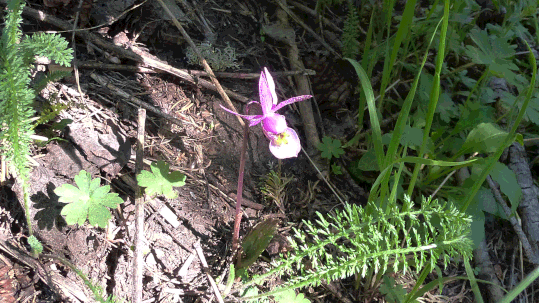New Mexico Wildflowers: Orchid Family
(Orchidaceae)
Flowers are organized alphabetically by genus and species. Hover over a photo series to control the images.
Calypso Orchid (Calypso bulbosa)

"Why, oh why, did I take just one quick snapshot of this orchid in 2016? I still haven't seen another one." Or so this commentary stated until 2023, when a visitor to the web site alerted me to a cluster of Calypso orchid blooms in the Sandias. A few days later I made it to the same spot, in time to see the tail end of this year's blooming season. Thank you, Rachael!
To me, Calypso orchids are the most gorgeous flower in the Sandia Mountains. They're tiny, as you can tell from pictures where my fingers intrude. (I'm holding the plant, not plucking it.) Each plant produces one orchid on a stalk, plus as little as one leaf down by the ground. Once you learn the leaf, you'll be able to recognize the plant even when it's not in bloom.
Summer (or Spotted) Coralroot Orchid (Corallorhiza maculata)
Littlefield and Burns include spotted coralroot orchids among their white flowers. I can see why, but the visible parts of the plants more closely resemble baby red asparagus spears. If you look closely, yes, those tiny flowers have white lower petals. Instead of relying on photosynthesis, this orchid species steals nutrients from fungi in the adjacent soil and leaf litter.
Striped Coralroot Orchid (Corallorhiza striata)
Another orchid species that looks a bit like red asparagus shoots from a distance; seen close up, this one is clearly striped rather than spotted. Like spotted coralroot orchids, the striped ones don't rely on photosynthesis and instead steal nutrients from fungi.
Rattlesnake Orchid (Goodyera oblongifolia)
This is a small, easily overlooked plant. The flowers are white; they look green-tinged from a distance, but the green comes from bracts. Even when this one isn't in bloom, the green-and-white leaves should allow an ID.



































